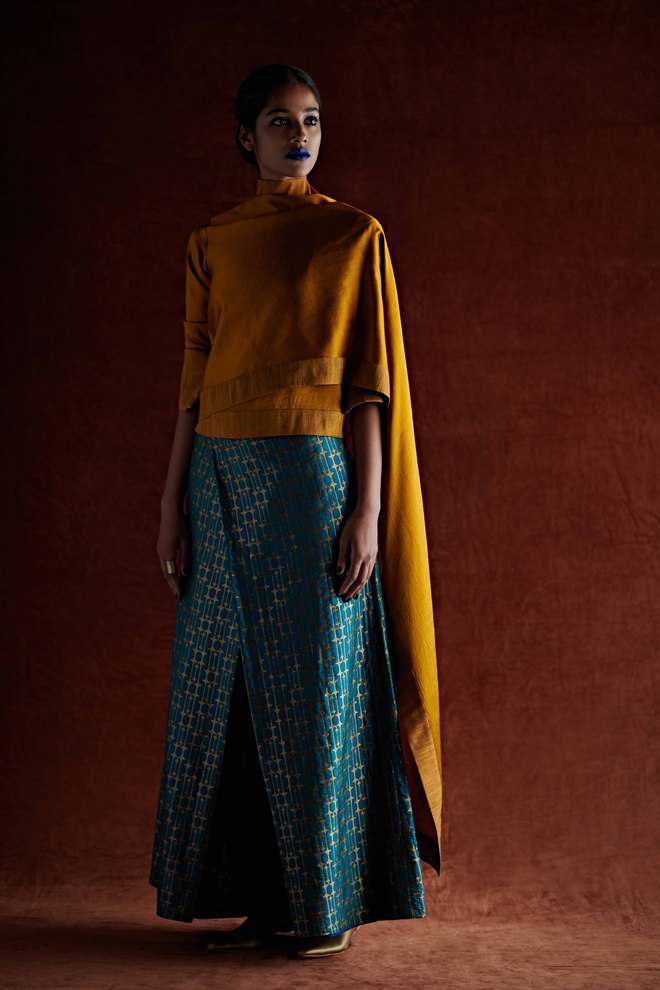
Arushi Chaudhary
Hues of blue interspersed with some deep mustard here and there, designer Payal Khandwala’s new prêt Autumn-Winter 2018 collection is an eye-soothing piece of work. With warm colours, figure-flattering drapes and practical cuts, each piece here is as desirable as the next. It is no wonder that the Mumbai-based designer’s pieces have found huge favour with Bollywood A-listers over the years. While the Autumn-Winter 2018 collection checks a lot of right boxes, what really stands out is the choice of colours Payal has worked with.
“The colour blue is predominant in this collection, as it has been inspired by the Tuaregs, an obscure Muslim semi-nomadic tribe from the Saharan desert of Africa with a lineage dating back a 1,000 years. They are a matrilineal people with an impressively progressive culture. Despite being what the modern world would describe as a primitive tribe, the Tuaregs’ societal fabric rests on gender equality. The women are respected members of society, they are owners of homes and animals, they have the liberty to choose their life partners and move on from relationships, and their opinions are greatly valued. The Tuareg women do not wear veils but the men conceal their faces from the moment they hit puberty and continue to do so in front of elders and women, except their girlfriends and wives. I found this societal dynamics to be amazing and intriguing at the same time and decide to create my Pret Autumn Winter 2018 collection as a tribute to their unique way of life,” Payal says.
“The dominant use of shades of blue is because the Tuaregs wear blues and indigos so often that their skin gets stained with these colours. Mustard has been used to represent the desert sand, so that a piece can create the illusion of a Tuareg standing against the backdrop of the vast Saharan desert,” she adds.
So, what moved Payal to base an entire collection after this lesser-known African tribe? “I chanced upon this tribe while searching for a specific shade of blue. As I started reading more and more about them, I was fascinated by how an obscure tribe that the majority of the world does not even know about has so effortlessly perfected the ideals that the modern world aspires for and struggles to achieve. Their way of life is a great commentary on social and gender equality. In these times, with movements like #metoo and #timeisup catching up and voices for women’s right getting louder than ever before, I thought basing my collection on the Tuaregs was only befitting,” she replies.
With top Bollywood personalities sporting Payal’s designs these days, Payal is ecstatic about all the exposure. “It is great that celebrities are wearing my designs. It definitely gives my work more access and exposure. However, I’m more excited to see my designs on a commoner because the real challenge lies in communicating with the quintessential girl next door. So, if I’m at an event or a wedding and I see someone wearing my label, I find a great sense of validation in that,” Payal says.
To make her designs more accessible to the common people, Payal has made a conscious decision to break away from the trend of excesses where wearing the same outfit twice is considered a fashion disaster. She achieves that by focusing on designing layered separates more than complete ensembles and keeping her collections somewhat aesthetically similar, giving people room to mix and match instead of buying completely new outfits for every occasion. Her Autumn-Winter Festive collection, for instance, has similar motifs and design elements as her Spring-Summer ethnic collection so that a new jacket can be matched with an existing skirt or a new dupatta can be used with an old kurta. This is also Payal’s way of making her fashion label more sustainable. “Sustainability is a huge focus for the fashion industry today, given how much waste ends up in our landfills. However, the responsibility for that rests equally with the buyers too. At my label, we try our best to minimise waste, reuse, recycle as much as possible. The onus of making use of it rests with the buyers. To be able to do that, there is a pressing need to break away from mindlessly following trends, and instead focus on developing a personal sense of style,” she says.
And how does she see her aesthetic sensibilities evolve over the years… “I find a marked difference between my first collection and some of my recent work. In the beginning, my designs used to be more complex and people had to really work their way around a piece to understand how to wear it right. Over the years, I have started leaning more toward simplicity. Today, I don’t design anything I wouldn’t wear. Also, I no longer create my designs for a perfect model body. These are consciously created to suit people of all body shapes, sizes and ages,” she replies.



























